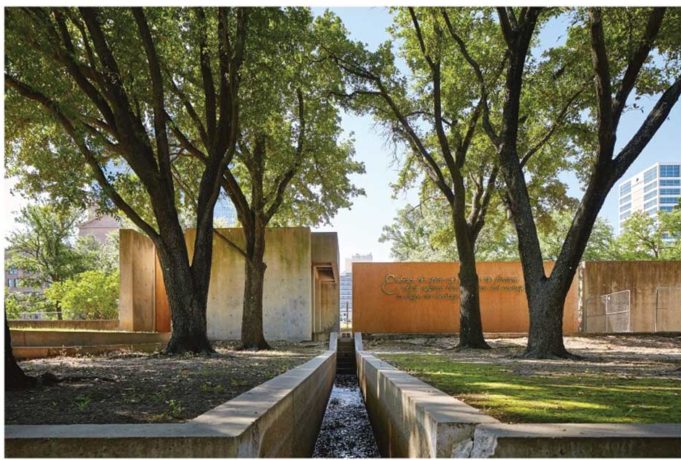Landscape architect Lawrence Halprin (1916-2009) had been established in private practice for 20 years in San Francisco when he was invited to Fort Worth in 1969 — to look at the Ditch.
Citizens of Cowtown had given this unflattering nickname to what remained of the Trinity River after major floods in 1949 and 1957 had prompted the extensive construction of levees and a wholesale rerouting of the watercourse through the city. Efficient and effective, the control projects by the U.S. Army Corps of Engineers had nonetheless made an eyesore out of a body of water that had been thought so beautiful by Spanish colonial governor Domingo Terán de los Rios in 1691 that he called it Encarnación de Verbo — the “Incarnation of the Word.”
By the early 1960s, there was little left of the river that had inspired such an appellation, now a muddy drainage ditch so polluted that it had been branded “septic” by the Public Health Service.
Fort Worth in the 1960s was struggling to assert itself as something more than just another prairie town, and civic leaders were beginning to embrace the spirit of high-minded patronage that gave rise to many of our enduring cultural institutions. Spurred by a desire to elevate the quality of life for their fellow citizens (for its own virtues as well as putting a thumb in the eye of Dallas), the city’s philanthropic class sought out progressive institutional models from the coasts for inspiration.
It was in this spirit that a self-appointed committee of concerned citizens, led by the preeminent benefactor of her time, Ruth Carter Stevenson, began to look at the Trinity River as not merely an unsightly problem but as an opportunity to reclaim a shared resource.
Halprin, who had recently completed the acclaimed Portland Open Space Sequence in Oregon, was very much the kind of leading-edge designer that fit Fort Worth’s desired profile, but he had also developed in his work a sensibility that was both humanistic and humane. He saw his urban projects as opportunities to integrate landscape with the fabric of the city in a way that served the needs of individuals and their communities coequally. He was commissioned by Stevenson’s committee (which would go on to become Streams & Valleys, Inc.) to prepare a report on the long-term potential of the Trinity River.
Delivered in 1970, the Fort Worth Trinity River Report became the genesis of the integrated parkscape we know and enjoy today. Our bike paths, the parks, and the beautification along the length of the Trinity, even Mayfest, can all be traced back to Halprin’s vision for the river. The river, after all, was the reason for the fort that became a city. A separate proposal, Halprin’s Fort Worth Central Business District Sector Report of 1971, had a similar influence on subsequent development in Downtown.
Stevenson recalled Halprin to Fort Worth in 1976 to design Heritage Park Plaza, a series of outdoor rooms constructed on the site of the original fort. A carefully choreographed sequence of water and paths on the bluff overlooking the Trinity, the half-acre park was built to reconnect the city to the river. The integration of water back into Downtown had begun two years earlier with the completion of Philip Johnson’s Water Gardens about a mile to the southeast. Johnson had been heavily influenced (to put it mildly) by Halprin’s Portland Open Space Sequence. Together, the two parks bookended Fort Worth’s Central Business District, establishing the parameters of subsequent development and revitalization.
Halprin’s career as a landscape architect was unparalleled, and it included such iconic projects as Seattle’s Freeway Park, the Sea Ranch in California, and the Franklin Delano Roosevelt Memorial in Washington, D.C. Likewise his influence on the design of public spaces cannot be overstated, as he set the terms for a democratization of use and accessibility that continues today.
Cities, though, have sometimes struggled with the maintenance and preservation of Halprin’s work, and some projects are threatened or have been destroyed. Our own Heritage Park Plaza was shuttered in 2007 — its location on the quiet edge of Downtown made it difficult to secure and maintain — and it might easily have suffered the fate of other lost or abandoned Halprin projects. Fortunately, Fort Worth’s civic spirit endures (for the most part), and new development on the north side of Downtown encouraged a revitalization of the park. A collaboration between the architecture and planning firm of Bennet Benner Partners in Fort Worth and the renowned Dallas landscape architecture firm Studio Outside, the restoration of Heritage Plaza (including a realignment of Main Street) is in process, pending funding.
Fort Worthians may reacquaint themselves with Halprin’s extensive body of work through a visit to the Fort Worth Community Arts Center. The Landscape Architecture of Lawrence Halprin is a photographic exhibition organized by The Cultural Landscape Foundation of Washington, D.C., and features 56 large-format images of Halprin’s work from a career that spanned six decades. With local exhibition design by Fort Worth architect W. Mark Gunderson and landscape architect Tary Arterburn of Studio Outside, the exhibit is an excellent survey of the designer’s lifetime of exploration into the qualities that make our shared spaces not only useable and worthwhile but also beautiful.
For Fort Worth, the exhibit is a homecoming of sorts for a designer who has been every bit as impactful on our shared quality of life as Philip Johnson, Tadao Ando, and Louis Kahn. It is an opportunity, too, to consider the words Halprin left for us at the source of our city: “Embrace the Spirit and Preserve the Freedom which inspired those of Vision and Courage to Shape our Heritage.”
Halprin and Fort Worth: Poetry in Place
Panel discussion w/Charles Birnbaum, FASLA; W. Mark Gunderson, AIA; and Gwendolyn McGinn 6-8pm Wed at Fort Worth Community Arts Center. Free.
The Landscape Architecture of Lawrence Halprin
Thru Feb 17 at Fort Worth Community Arts Center, 1300 Gendy St, FW. Free. 817-738-1938.













Thank you for this thoughtful article.
The BBP and Studio Outside partnership was hired by Downtown Fort Worth Initiatives, Inc. (DFWII) to conduct the renovation planning and design work. This work is now complete, and a Phase 2 program of work is now underway with BBP and Michael Verguson.
DFWII staff and volunteers and the City of Fort Worth are collaborating on the renovation and reopening of the Plaza with generous funding provided by the Amon G. Carter Foundation, Streams and Valleys and the Sid Richardson Foundation. A significant community fundraising effort will be required before work can begin.